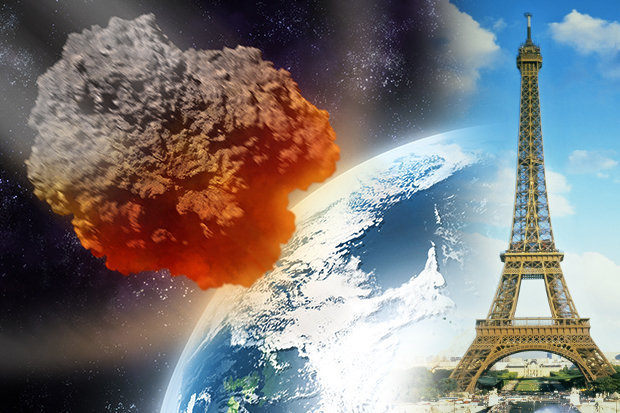The newly-discovered space rock – dubbed Asteroid 2018 CB – is expected to zoom past our planet at around 10.30pm GMT.
It will be travelling at a speed close to five miles per second and will pass at a distance of about 39,000 miles.
That’s just one-fifth of the distance from Earth to the Moon and it’s a distance considered incredibly close in space terms.
According to NASA, the chunk of rock is a whopping 40m wide, which would be double the size of the meteor that almost wiped out Chelyabinsk in Russia almost five years ago.
That also makes it taller than the Eiffel Tower, which stands at 35m.
The passing comes just one week after Asteroid 2018 DV1 soared past Earth at a distance of just 27,000 miles above the surface.
Just yesterday, Daily Star Online revealed how space boffins were drawing up plans to fire a nuclear weapon at an asteroid amid fears Earth could be hit by a giant space rock.
Asteroid 2018 CB has been classed by NASA as “potentially hazardous” because of the sheer proximity from Earth.
But thankfully, experts predict there is no threat of it hitting our planet.
“Asteroids of this size do not often approach this close to our planet — maybe only once or twice a year,” Paul Chodas, manager of the Center for Near-Earth Object Studies at NASA’s Jet Propulsion Laboratory in California, said in a statement from the agency.
He added: “Although 2018 CB is quite small, it might well be larger than the asteroid that entered the atmosphere over Chelyabinsk, Russia, almost exactly five years ago, in 2013.”
The asteroid was discovered by the NASA-funded Catalina Sky Survey (CSS) near Tucson, Arizona.

And while it is expected to miss our planet, if it did hit Earth, experts believe it would be worst than the impact of the 59ft asteroid that hit the city of Chelyabinsk in Russia in 2013.
That particular blast injured around 1,500 people, and damaged over 7,000 buildings.
Fears have been raised by the sheer number of “potentially hazardous” asteroids that have come incredibly close to Earth.
NASA has admitted it would need decades to prepare for an asteroid strike, adding it would be “impossible” to shoot it off course.












